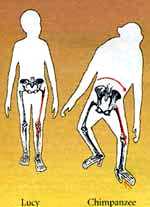Two legs to stand on
 Walking on 2 legs is probably the most fundamental feature that distinguishes humans from their closest kin, the chimpanzee -- certainly, much more so than language, culture or technology. The general belief is that humans are 2-legged apes who slowly acquired all the qualities that define them now. Darwin's theory that bipedalism, tool-making and intelligence evolved simultaneously hasn't been borne out by the fossil record.
Walking on 2 legs is probably the most fundamental feature that distinguishes humans from their closest kin, the chimpanzee -- certainly, much more so than language, culture or technology. The general belief is that humans are 2-legged apes who slowly acquired all the qualities that define them now. Darwin's theory that bipedalism, tool-making and intelligence evolved simultaneously hasn't been borne out by the fossil record.
Of the several hypotheses advanced in recent years, 2 seem most interesting. The first, proposed by the American anatomist, Owen Lovejoy, posits that hominids became bipeds for some specific biological reason. It wasn't merely locomotion, because walking on 2 legs is a lousy way of getting around. It must have been for lugging things, Lovejoy concluded, as the hands, freed from movement, could carry objects.
According to Lovejoy, those who walked more frequently enjoyed a reproductive edge, despite loss in efficiency. He argues thus: apes reproduce slowly, once every 4 years. If the bipedal ape could produce more offspring, it would have higher survival possibilities. Because much of biology is energy-driven, a greater number of offspring would require greater effort by the female of the species. If the male provides the female with food, the female would have more energy for parenting. In order to provide food for the female, the male should be able to walk, freeing the hands to carry things.
The other hypothesis was put forward by Peter Rodman and Henry McHenry of the University of California at Davis in the US. They argue that as chimpanzees need the same amount of energy to walk on all fours and on 2 legs, there was no energy barrier to the evolution of 2-leggedness. So, for an ape trapped in an environment where the more efficient way of movement would be advantageous, the evolution of bipedalism is a likely outcome.
Anthropologists have imagined several environmental scenarios that favoured such a change. Add to this the mysterious fact that there is absolutely no sign of apes or their direct ancestors in eastern Africa, even as molecular biologists keep reminding us that humans and chimpanzees are extremely close molecularly, which in evolutionary terms means that they had share a common ancestor not very far back in time.
The answer to both the puzzles lies in the history of the Great Rift Valley of Africa. Fossil-hunter Yves Coppens of the College of France has suggested that about 8 million years ago, a strong earthquake caused the Rift Valley to sink several thousand metres, creating a natural barrier between eastern Africa and the rest of the continent and separating the human and ape species. The West remained humid and the East evolved in the open savannah, which resulted in the hominid bipeds.
Recently, however, researchers have uncovered a new source of evidence-a chamber in the inner ear that helps us to maintain our balance- which has challenged the supposed 2-leggedness of Lucy and her comtemporaries. Frd Spoor, a Dutch anatomist at the University of London, has found that the inner ears of 4 Australopithecus specimens resemble those of gorrilas and chimps.
